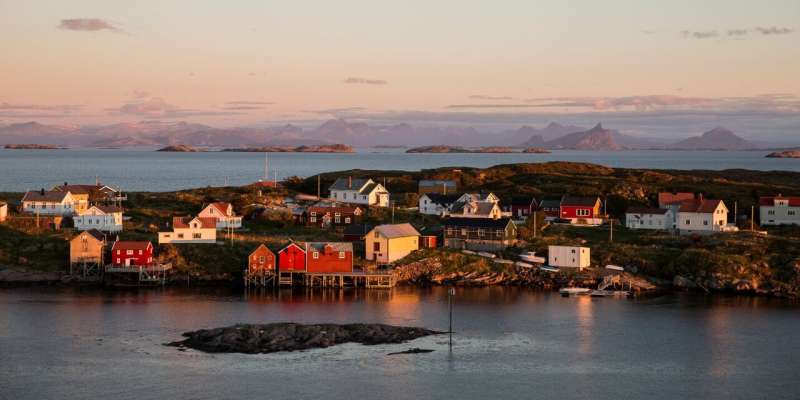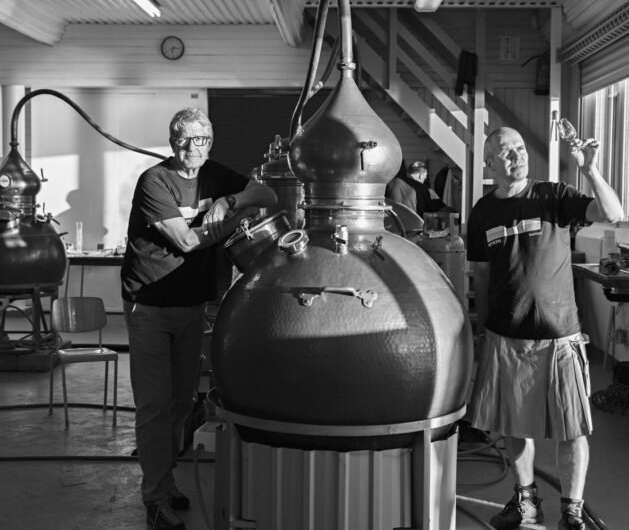Hydrogen plant will make the 'whisky island' Myken self-sufficient in electricity

Surrounded by the sea off the coast of Helgeland in Mid-Norway, lies an island called Myken. This small island has about ten permanent inhabitants, and for more than 50 years has been supplied with electricity via a 32-kilometer submarine cable. The cable is now so old that it should really be replaced.
A fracture that appeared last spring resulted in two months without power, so the island community took matters into their own hands and started looking into a better way of sourcing their electricity.
Trude Tokle, who is project manager for this energy project, and co-owner of the island's gin and whisky distillery, also called Myken, tells Gemini that above all else, they are working to identify a sustainable solution that reduces the vulnerability of the island's residents and local businesses. And now they have researchers from SINTEF on their team!
"Our island is located far out at sea, so as far as possible we should be taking care of things ourselves," says Tokle. "This is why we want to become entirely self-sufficient in energy. It is also important to us to be using green, renewable energy if at all possible," she says.
Much points to the idea that the solution may lie in a hydrogen plant, specifically tailored for small islands. The "raw materials" for hydrogen production come from nature itself in the form of the sun and wind.
"The potential is enormous," says Kyrre Sundseth, who is a hydrogen researcher at SINTEF. "In Norway alone there are about 300 islands inhabited all year round by small populations, all depending on a meagre selection of expensive electricity supply options. All of these islands may be candidates for using this technology. In global terms we're talking about 10,000 similar islands," he says.
As part of the EU project REMOTE, SINTEF has carried out several analyses on a similar hydrogen plant planned for the small island of Froan, lying offshore the county of Trøndelag. Here, SINTEF researchers have calculated that energy costs will be lower using hydrogen production than for alternative fossil fuel or submarine cable options.
"The main reason for this is that it is possible to store energy in the form of hydrogen for longer periods. This means that supplies will not have to rely on a lot of expensive batteries or external energy sources, even during periods when the sun isn't shining, or the wind isn't blowing," explains Sundseth.
Worries about using diesel
When Myken's submarine cable was damaged, the island had to rely on a diesel generator. Every day for two months, 700 liters of diesel were delivered to the island. The generator, located in the very heart of the island, was noisy and polluting.
The island community would prefer to avoid having to experience this again.
According to Tokle, both residents and business interests are worried that if they don't succeed in finding a better option, the generator may end up becoming a permanent fixture.
"The electricity company is obliged to supply us with electricity, but we're uncertain as to what kind of system it will propose," says Tokle. "It is not required to supply green energy and, due to regulation provisions and economic factors, it has so far not wanted to make any promises," she says. She emphasizes that the company is positive about helping to identify a green solution, and is participating in the project.
Tokle believes that a diesel-based system on Myken will have major consequences for local businesses.
"The island offers both overnight accommodation with meals, as well as a whisky distillery that attracts tourists. However, I fail to see how we can make Myken into an attractive place to visit while we have a diesel aggregate on the island. At the distillery, it is very important to us to be able to welcome visitors because this helps promote Myken's gin and whisky products in the market," she says.

More sustainable and cost-effective
The Myken project has attracted several major players. As well as SINTEF, participants include the companies Greenstat and Nordlandsnett, the technology company TechnipFMC, Glomfjord Hydrogen, and the green energy funding organization Enova, which is supporting the project with a grant of NOK 700,000.
Project participants are currently working on a pilot project that is looking into the concept, and also the potential linked to installing a hydrogen plant on Myken that will make the island self-sufficient in renewable energy.
The pilot will involve testing a hydrogen system in which electricity is generated from solar and wind sources. This electricity can be used immediately, but during periods when all the energy generated is not required, the surplus can be used to split seawater into hydrogen and oxygen.
"The hydrogen can be stored in a tank, and used later to generate the electricity needed using fuel cells," says Sundseth, adding that on Myken, it will be more sustainable and cost-effective to invest in a hydrogen plant rather than other options such as laying a new submarine cable or using fossil fuels.
Extra environmental benefit for Myken
According to Sundseth, the installation of a hydrogen plant on Myken offers an even greater environmental benefit due to the fact that the whisky distillery relies on propane in the distillation process. The propane is delivered by a diesel-driven vessel.
"We envisage that hydrogen, rather than propane, be used as the fuel gas for distillation," says Sundseth. "Surplus heat from the hydrogen system can also be used for heating as part of the mashing and distillation processes," he says.
On Myken, the distillery is installed in an old fish processing plant. From the distillery down to the quay, there is a steep road that freezes over each winter. The researchers believe that a pipeline can be laid beneath the road and used to carry surplus heat that can keep the road free of ice.
"In the future, it might also be possible to use the hydrogen for other applications, such as in local, zero-emissions, fuel cell-driven vessels. The oxygen can be used in the aquaculture sector, although this is not currently a standard application," says Sundseth.
Enormous opportunities for sustainable initiatives
"This winter, we will have the equipment ready in Rye outside Trondheim. This will be tested in collaboration with electricity suppliers Trønder Energi as part of the REMOTE project," says Sundseth. "When testing is complete we will know more about how effectively the system will work," he says.
In addition to the Myken and Froan projects, SINTEF is working with many similar initiatives across Europe. If these are successful, there may be some major future environmental spin-offs.
"The potential is enormous," says Sundseth. "In Norway alone there are about 300 islands inhabited all year round by small populations, all depending on a meager selection of expensive electricity supply options. All of these islands may be candidates for using this technology. In global terms we're talking about 10,000 similar islands," he says.
















